HS2101 - Building Therapeutic Relationships in Aboriginal Care
VerifiedAdded on 2023/06/08
|8
|2346
|324
Essay
AI Summary
This essay explores the importance of cultural competence in establishing therapeutic relationships with Aboriginal patients. It emphasizes the holistic view of health held by Aboriginal communities, encompassing emotional, physical, social, cultural, and spiritual well-being. The essay discusses the need for healthcare professionals to develop cultural awareness and knowledge to meet the specific needs and expectations of Aboriginal patients, considering the diversity within these communities. It addresses potential barriers such as fear, distrust, cultural misunderstandings, and financial burdens that may hinder the development of therapeutic relationships. The importance of trust, culturally competent communication (both verbal and non-verbal), and respect for cultural differences, such as the use of silence and eye contact, are highlighted. The essay also addresses the role of family and support persons in Aboriginal healthcare and the need for professionals to be sensitive to their needs and concerns. Ultimately, the essay concludes that cultural competency, mutual respect, and effective communication are essential for ensuring positive health outcomes and meeting the holistic needs of Aboriginal patients.
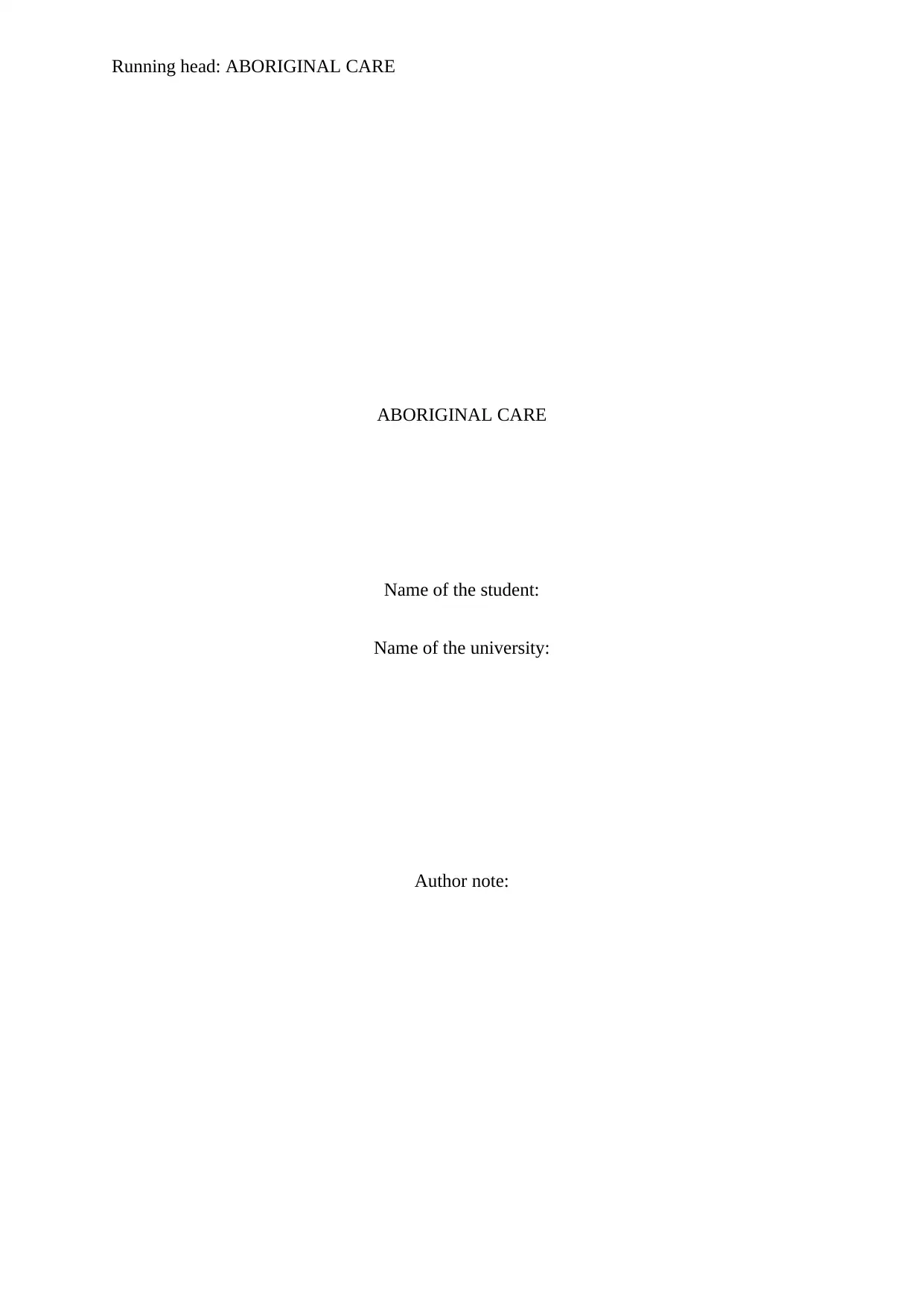
Running head: ABORIGINAL CARE
ABORIGINAL CARE
Name of the student:
Name of the university:
Author note:
ABORIGINAL CARE
Name of the student:
Name of the university:
Author note:
Paraphrase This Document
Need a fresh take? Get an instant paraphrase of this document with our AI Paraphraser
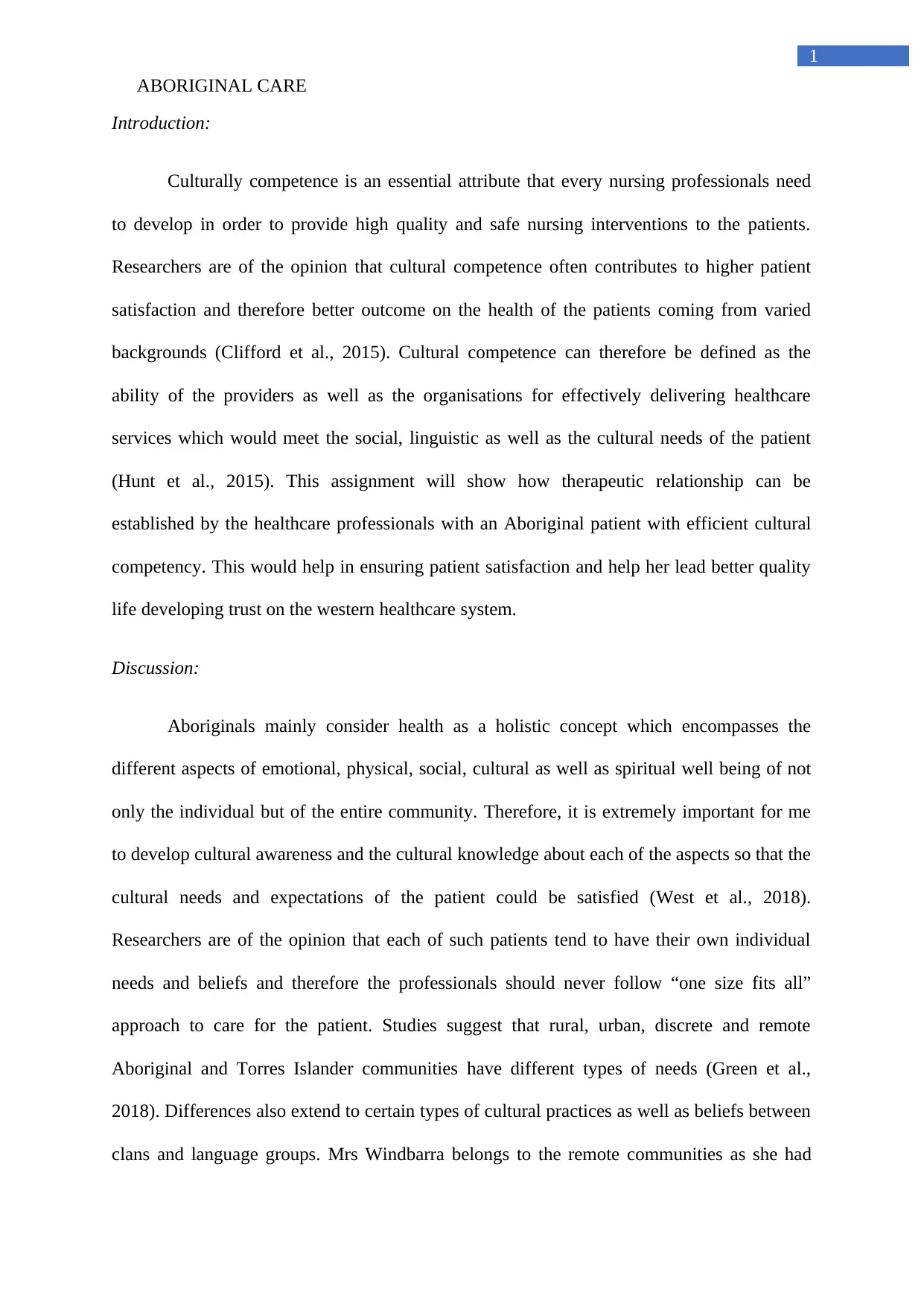
1
ABORIGINAL CARE
Introduction:
Culturally competence is an essential attribute that every nursing professionals need
to develop in order to provide high quality and safe nursing interventions to the patients.
Researchers are of the opinion that cultural competence often contributes to higher patient
satisfaction and therefore better outcome on the health of the patients coming from varied
backgrounds (Clifford et al., 2015). Cultural competence can therefore be defined as the
ability of the providers as well as the organisations for effectively delivering healthcare
services which would meet the social, linguistic as well as the cultural needs of the patient
(Hunt et al., 2015). This assignment will show how therapeutic relationship can be
established by the healthcare professionals with an Aboriginal patient with efficient cultural
competency. This would help in ensuring patient satisfaction and help her lead better quality
life developing trust on the western healthcare system.
Discussion:
Aboriginals mainly consider health as a holistic concept which encompasses the
different aspects of emotional, physical, social, cultural as well as spiritual well being of not
only the individual but of the entire community. Therefore, it is extremely important for me
to develop cultural awareness and the cultural knowledge about each of the aspects so that the
cultural needs and expectations of the patient could be satisfied (West et al., 2018).
Researchers are of the opinion that each of such patients tend to have their own individual
needs and beliefs and therefore the professionals should never follow “one size fits all”
approach to care for the patient. Studies suggest that rural, urban, discrete and remote
Aboriginal and Torres Islander communities have different types of needs (Green et al.,
2018). Differences also extend to certain types of cultural practices as well as beliefs between
clans and language groups. Mrs Windbarra belongs to the remote communities as she had
ABORIGINAL CARE
Introduction:
Culturally competence is an essential attribute that every nursing professionals need
to develop in order to provide high quality and safe nursing interventions to the patients.
Researchers are of the opinion that cultural competence often contributes to higher patient
satisfaction and therefore better outcome on the health of the patients coming from varied
backgrounds (Clifford et al., 2015). Cultural competence can therefore be defined as the
ability of the providers as well as the organisations for effectively delivering healthcare
services which would meet the social, linguistic as well as the cultural needs of the patient
(Hunt et al., 2015). This assignment will show how therapeutic relationship can be
established by the healthcare professionals with an Aboriginal patient with efficient cultural
competency. This would help in ensuring patient satisfaction and help her lead better quality
life developing trust on the western healthcare system.
Discussion:
Aboriginals mainly consider health as a holistic concept which encompasses the
different aspects of emotional, physical, social, cultural as well as spiritual well being of not
only the individual but of the entire community. Therefore, it is extremely important for me
to develop cultural awareness and the cultural knowledge about each of the aspects so that the
cultural needs and expectations of the patient could be satisfied (West et al., 2018).
Researchers are of the opinion that each of such patients tend to have their own individual
needs and beliefs and therefore the professionals should never follow “one size fits all”
approach to care for the patient. Studies suggest that rural, urban, discrete and remote
Aboriginal and Torres Islander communities have different types of needs (Green et al.,
2018). Differences also extend to certain types of cultural practices as well as beliefs between
clans and language groups. Mrs Windbarra belongs to the remote communities as she had
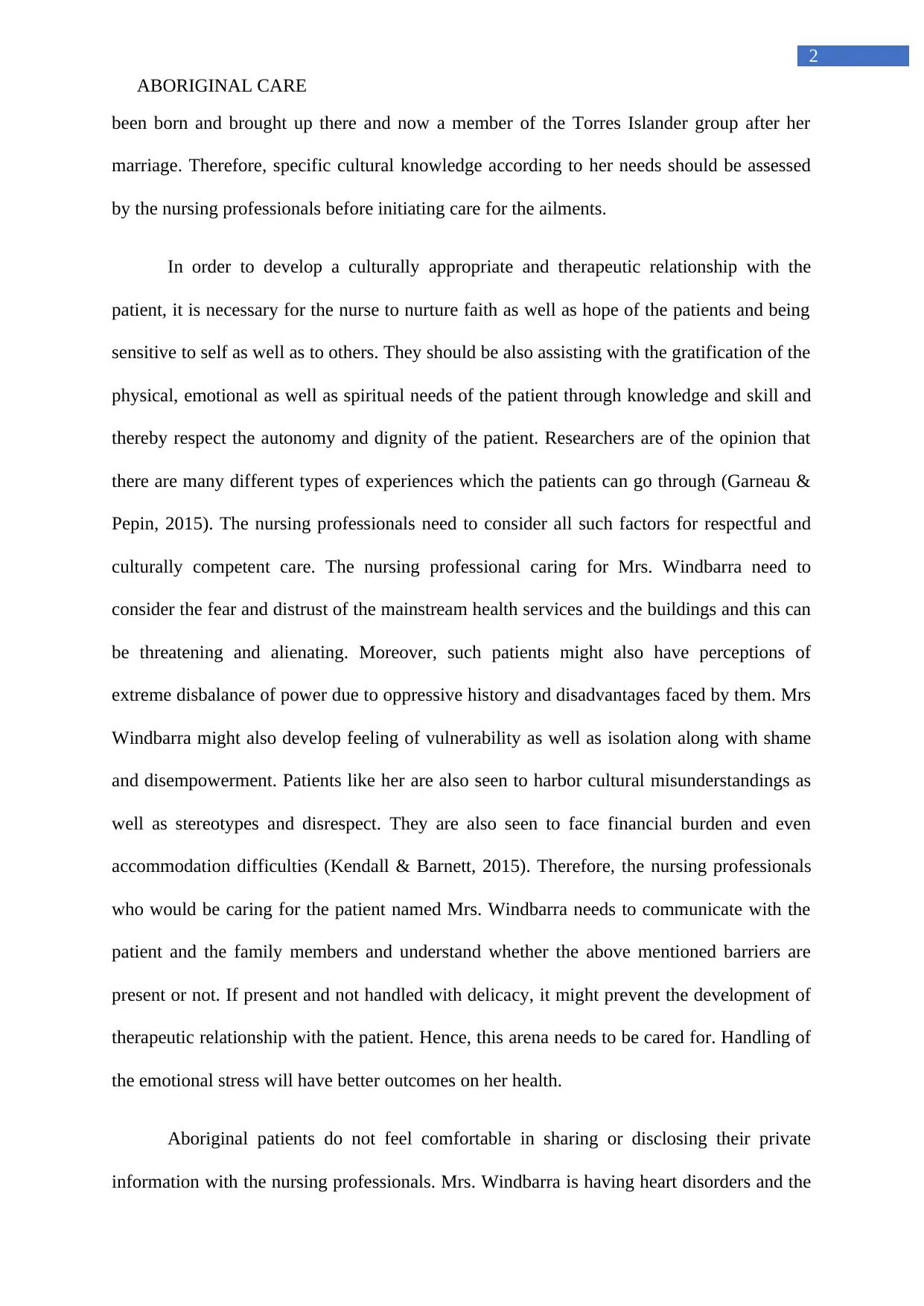
2
ABORIGINAL CARE
been born and brought up there and now a member of the Torres Islander group after her
marriage. Therefore, specific cultural knowledge according to her needs should be assessed
by the nursing professionals before initiating care for the ailments.
In order to develop a culturally appropriate and therapeutic relationship with the
patient, it is necessary for the nurse to nurture faith as well as hope of the patients and being
sensitive to self as well as to others. They should be also assisting with the gratification of the
physical, emotional as well as spiritual needs of the patient through knowledge and skill and
thereby respect the autonomy and dignity of the patient. Researchers are of the opinion that
there are many different types of experiences which the patients can go through (Garneau &
Pepin, 2015). The nursing professionals need to consider all such factors for respectful and
culturally competent care. The nursing professional caring for Mrs. Windbarra need to
consider the fear and distrust of the mainstream health services and the buildings and this can
be threatening and alienating. Moreover, such patients might also have perceptions of
extreme disbalance of power due to oppressive history and disadvantages faced by them. Mrs
Windbarra might also develop feeling of vulnerability as well as isolation along with shame
and disempowerment. Patients like her are also seen to harbor cultural misunderstandings as
well as stereotypes and disrespect. They are also seen to face financial burden and even
accommodation difficulties (Kendall & Barnett, 2015). Therefore, the nursing professionals
who would be caring for the patient named Mrs. Windbarra needs to communicate with the
patient and the family members and understand whether the above mentioned barriers are
present or not. If present and not handled with delicacy, it might prevent the development of
therapeutic relationship with the patient. Hence, this arena needs to be cared for. Handling of
the emotional stress will have better outcomes on her health.
Aboriginal patients do not feel comfortable in sharing or disclosing their private
information with the nursing professionals. Mrs. Windbarra is having heart disorders and the
ABORIGINAL CARE
been born and brought up there and now a member of the Torres Islander group after her
marriage. Therefore, specific cultural knowledge according to her needs should be assessed
by the nursing professionals before initiating care for the ailments.
In order to develop a culturally appropriate and therapeutic relationship with the
patient, it is necessary for the nurse to nurture faith as well as hope of the patients and being
sensitive to self as well as to others. They should be also assisting with the gratification of the
physical, emotional as well as spiritual needs of the patient through knowledge and skill and
thereby respect the autonomy and dignity of the patient. Researchers are of the opinion that
there are many different types of experiences which the patients can go through (Garneau &
Pepin, 2015). The nursing professionals need to consider all such factors for respectful and
culturally competent care. The nursing professional caring for Mrs. Windbarra need to
consider the fear and distrust of the mainstream health services and the buildings and this can
be threatening and alienating. Moreover, such patients might also have perceptions of
extreme disbalance of power due to oppressive history and disadvantages faced by them. Mrs
Windbarra might also develop feeling of vulnerability as well as isolation along with shame
and disempowerment. Patients like her are also seen to harbor cultural misunderstandings as
well as stereotypes and disrespect. They are also seen to face financial burden and even
accommodation difficulties (Kendall & Barnett, 2015). Therefore, the nursing professionals
who would be caring for the patient named Mrs. Windbarra needs to communicate with the
patient and the family members and understand whether the above mentioned barriers are
present or not. If present and not handled with delicacy, it might prevent the development of
therapeutic relationship with the patient. Hence, this arena needs to be cared for. Handling of
the emotional stress will have better outcomes on her health.
Aboriginal patients do not feel comfortable in sharing or disclosing their private
information with the nursing professionals. Mrs. Windbarra is having heart disorders and the
⊘ This is a preview!⊘
Do you want full access?
Subscribe today to unlock all pages.

Trusted by 1+ million students worldwide
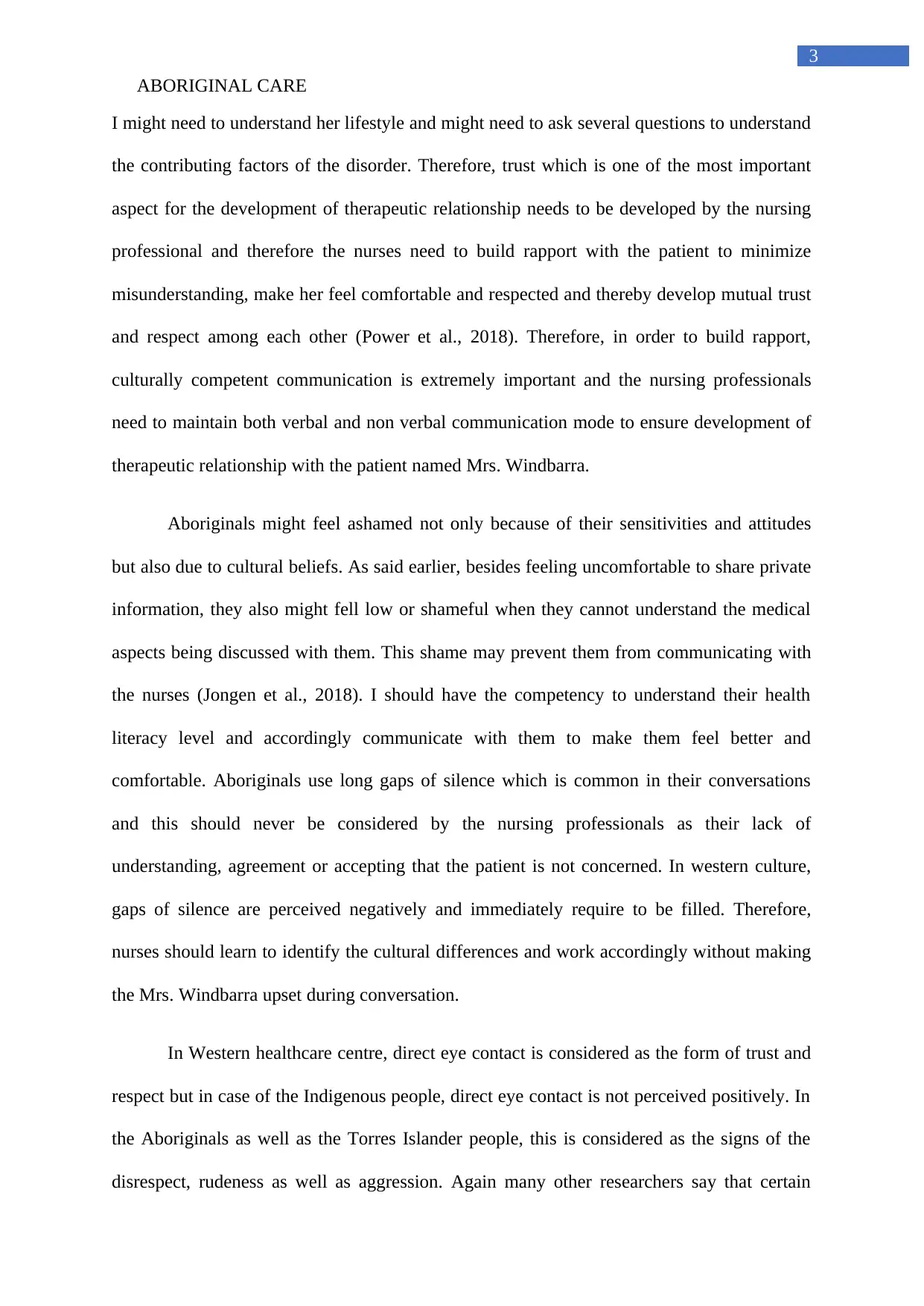
3
ABORIGINAL CARE
I might need to understand her lifestyle and might need to ask several questions to understand
the contributing factors of the disorder. Therefore, trust which is one of the most important
aspect for the development of therapeutic relationship needs to be developed by the nursing
professional and therefore the nurses need to build rapport with the patient to minimize
misunderstanding, make her feel comfortable and respected and thereby develop mutual trust
and respect among each other (Power et al., 2018). Therefore, in order to build rapport,
culturally competent communication is extremely important and the nursing professionals
need to maintain both verbal and non verbal communication mode to ensure development of
therapeutic relationship with the patient named Mrs. Windbarra.
Aboriginals might feel ashamed not only because of their sensitivities and attitudes
but also due to cultural beliefs. As said earlier, besides feeling uncomfortable to share private
information, they also might fell low or shameful when they cannot understand the medical
aspects being discussed with them. This shame may prevent them from communicating with
the nurses (Jongen et al., 2018). I should have the competency to understand their health
literacy level and accordingly communicate with them to make them feel better and
comfortable. Aboriginals use long gaps of silence which is common in their conversations
and this should never be considered by the nursing professionals as their lack of
understanding, agreement or accepting that the patient is not concerned. In western culture,
gaps of silence are perceived negatively and immediately require to be filled. Therefore,
nurses should learn to identify the cultural differences and work accordingly without making
the Mrs. Windbarra upset during conversation.
In Western healthcare centre, direct eye contact is considered as the form of trust and
respect but in case of the Indigenous people, direct eye contact is not perceived positively. In
the Aboriginals as well as the Torres Islander people, this is considered as the signs of the
disrespect, rudeness as well as aggression. Again many other researchers say that certain
ABORIGINAL CARE
I might need to understand her lifestyle and might need to ask several questions to understand
the contributing factors of the disorder. Therefore, trust which is one of the most important
aspect for the development of therapeutic relationship needs to be developed by the nursing
professional and therefore the nurses need to build rapport with the patient to minimize
misunderstanding, make her feel comfortable and respected and thereby develop mutual trust
and respect among each other (Power et al., 2018). Therefore, in order to build rapport,
culturally competent communication is extremely important and the nursing professionals
need to maintain both verbal and non verbal communication mode to ensure development of
therapeutic relationship with the patient named Mrs. Windbarra.
Aboriginals might feel ashamed not only because of their sensitivities and attitudes
but also due to cultural beliefs. As said earlier, besides feeling uncomfortable to share private
information, they also might fell low or shameful when they cannot understand the medical
aspects being discussed with them. This shame may prevent them from communicating with
the nurses (Jongen et al., 2018). I should have the competency to understand their health
literacy level and accordingly communicate with them to make them feel better and
comfortable. Aboriginals use long gaps of silence which is common in their conversations
and this should never be considered by the nursing professionals as their lack of
understanding, agreement or accepting that the patient is not concerned. In western culture,
gaps of silence are perceived negatively and immediately require to be filled. Therefore,
nurses should learn to identify the cultural differences and work accordingly without making
the Mrs. Windbarra upset during conversation.
In Western healthcare centre, direct eye contact is considered as the form of trust and
respect but in case of the Indigenous people, direct eye contact is not perceived positively. In
the Aboriginals as well as the Torres Islander people, this is considered as the signs of the
disrespect, rudeness as well as aggression. Again many other researchers say that certain
Paraphrase This Document
Need a fresh take? Get an instant paraphrase of this document with our AI Paraphraser
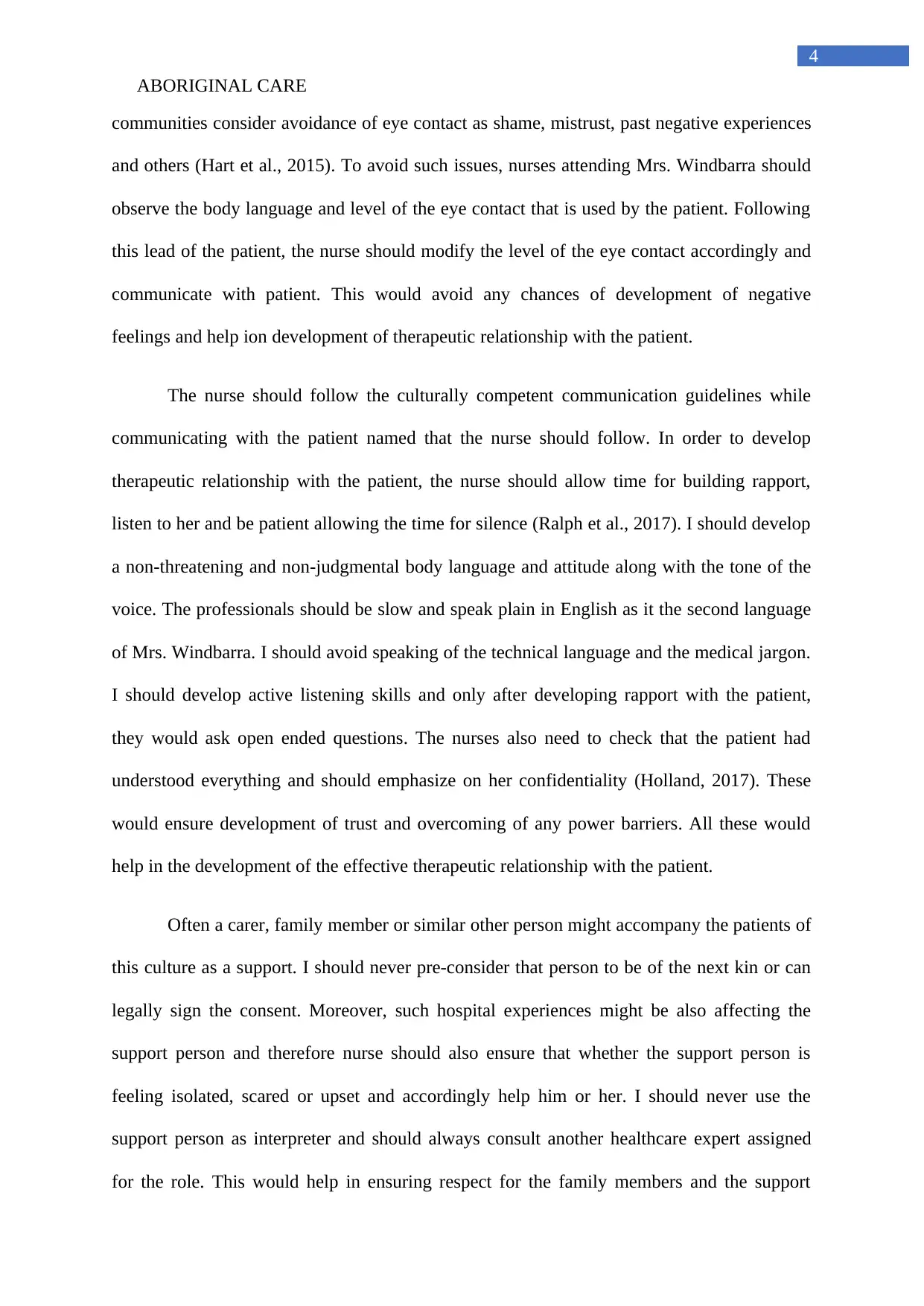
4
ABORIGINAL CARE
communities consider avoidance of eye contact as shame, mistrust, past negative experiences
and others (Hart et al., 2015). To avoid such issues, nurses attending Mrs. Windbarra should
observe the body language and level of the eye contact that is used by the patient. Following
this lead of the patient, the nurse should modify the level of the eye contact accordingly and
communicate with patient. This would avoid any chances of development of negative
feelings and help ion development of therapeutic relationship with the patient.
The nurse should follow the culturally competent communication guidelines while
communicating with the patient named that the nurse should follow. In order to develop
therapeutic relationship with the patient, the nurse should allow time for building rapport,
listen to her and be patient allowing the time for silence (Ralph et al., 2017). I should develop
a non-threatening and non-judgmental body language and attitude along with the tone of the
voice. The professionals should be slow and speak plain in English as it the second language
of Mrs. Windbarra. I should avoid speaking of the technical language and the medical jargon.
I should develop active listening skills and only after developing rapport with the patient,
they would ask open ended questions. The nurses also need to check that the patient had
understood everything and should emphasize on her confidentiality (Holland, 2017). These
would ensure development of trust and overcoming of any power barriers. All these would
help in the development of the effective therapeutic relationship with the patient.
Often a carer, family member or similar other person might accompany the patients of
this culture as a support. I should never pre-consider that person to be of the next kin or can
legally sign the consent. Moreover, such hospital experiences might be also affecting the
support person and therefore nurse should also ensure that whether the support person is
feeling isolated, scared or upset and accordingly help him or her. I should never use the
support person as interpreter and should always consult another healthcare expert assigned
for the role. This would help in ensuring respect for the family members and the support
ABORIGINAL CARE
communities consider avoidance of eye contact as shame, mistrust, past negative experiences
and others (Hart et al., 2015). To avoid such issues, nurses attending Mrs. Windbarra should
observe the body language and level of the eye contact that is used by the patient. Following
this lead of the patient, the nurse should modify the level of the eye contact accordingly and
communicate with patient. This would avoid any chances of development of negative
feelings and help ion development of therapeutic relationship with the patient.
The nurse should follow the culturally competent communication guidelines while
communicating with the patient named that the nurse should follow. In order to develop
therapeutic relationship with the patient, the nurse should allow time for building rapport,
listen to her and be patient allowing the time for silence (Ralph et al., 2017). I should develop
a non-threatening and non-judgmental body language and attitude along with the tone of the
voice. The professionals should be slow and speak plain in English as it the second language
of Mrs. Windbarra. I should avoid speaking of the technical language and the medical jargon.
I should develop active listening skills and only after developing rapport with the patient,
they would ask open ended questions. The nurses also need to check that the patient had
understood everything and should emphasize on her confidentiality (Holland, 2017). These
would ensure development of trust and overcoming of any power barriers. All these would
help in the development of the effective therapeutic relationship with the patient.
Often a carer, family member or similar other person might accompany the patients of
this culture as a support. I should never pre-consider that person to be of the next kin or can
legally sign the consent. Moreover, such hospital experiences might be also affecting the
support person and therefore nurse should also ensure that whether the support person is
feeling isolated, scared or upset and accordingly help him or her. I should never use the
support person as interpreter and should always consult another healthcare expert assigned
for the role. This would help in ensuring respect for the family members and the support
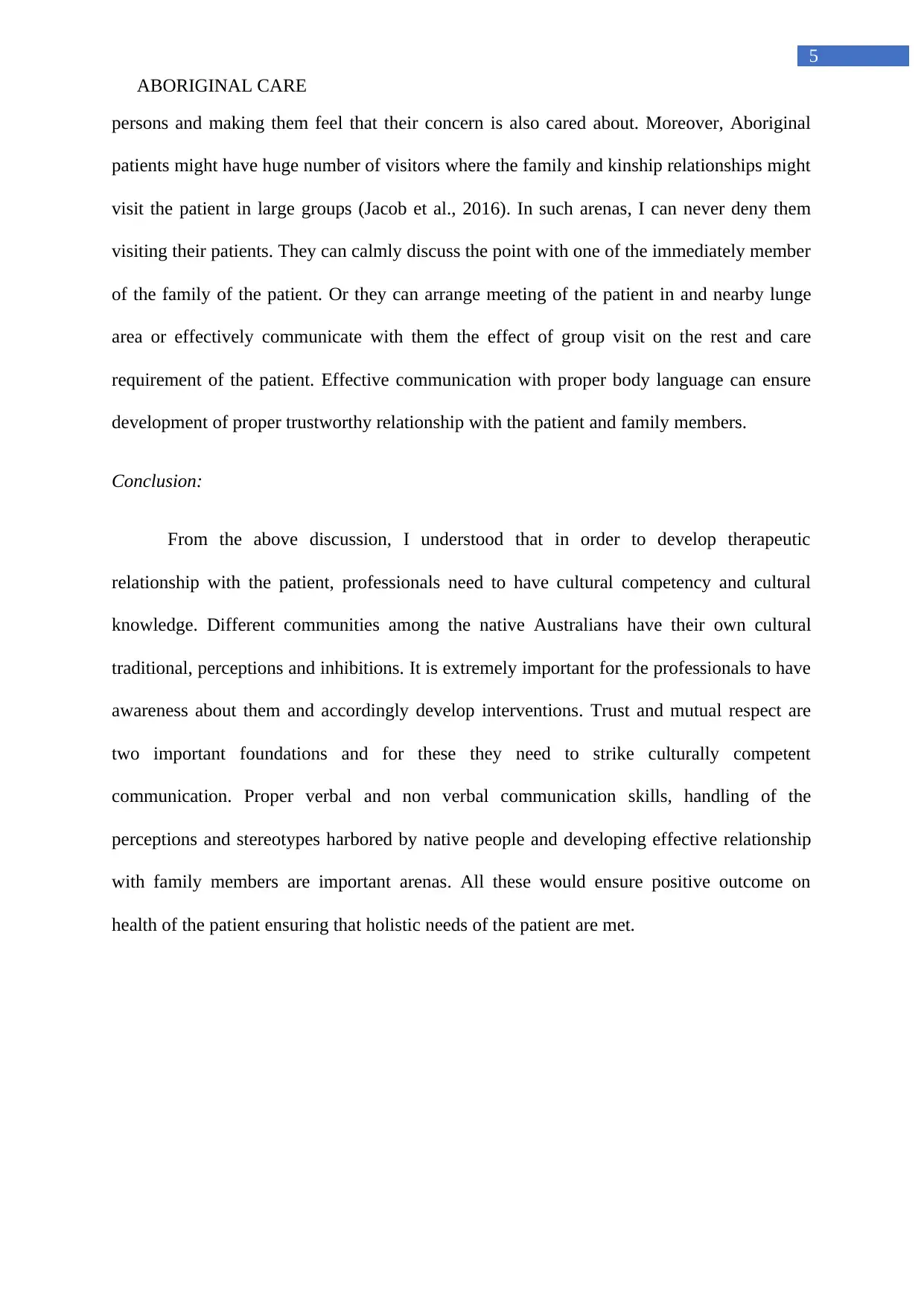
5
ABORIGINAL CARE
persons and making them feel that their concern is also cared about. Moreover, Aboriginal
patients might have huge number of visitors where the family and kinship relationships might
visit the patient in large groups (Jacob et al., 2016). In such arenas, I can never deny them
visiting their patients. They can calmly discuss the point with one of the immediately member
of the family of the patient. Or they can arrange meeting of the patient in and nearby lunge
area or effectively communicate with them the effect of group visit on the rest and care
requirement of the patient. Effective communication with proper body language can ensure
development of proper trustworthy relationship with the patient and family members.
Conclusion:
From the above discussion, I understood that in order to develop therapeutic
relationship with the patient, professionals need to have cultural competency and cultural
knowledge. Different communities among the native Australians have their own cultural
traditional, perceptions and inhibitions. It is extremely important for the professionals to have
awareness about them and accordingly develop interventions. Trust and mutual respect are
two important foundations and for these they need to strike culturally competent
communication. Proper verbal and non verbal communication skills, handling of the
perceptions and stereotypes harbored by native people and developing effective relationship
with family members are important arenas. All these would ensure positive outcome on
health of the patient ensuring that holistic needs of the patient are met.
ABORIGINAL CARE
persons and making them feel that their concern is also cared about. Moreover, Aboriginal
patients might have huge number of visitors where the family and kinship relationships might
visit the patient in large groups (Jacob et al., 2016). In such arenas, I can never deny them
visiting their patients. They can calmly discuss the point with one of the immediately member
of the family of the patient. Or they can arrange meeting of the patient in and nearby lunge
area or effectively communicate with them the effect of group visit on the rest and care
requirement of the patient. Effective communication with proper body language can ensure
development of proper trustworthy relationship with the patient and family members.
Conclusion:
From the above discussion, I understood that in order to develop therapeutic
relationship with the patient, professionals need to have cultural competency and cultural
knowledge. Different communities among the native Australians have their own cultural
traditional, perceptions and inhibitions. It is extremely important for the professionals to have
awareness about them and accordingly develop interventions. Trust and mutual respect are
two important foundations and for these they need to strike culturally competent
communication. Proper verbal and non verbal communication skills, handling of the
perceptions and stereotypes harbored by native people and developing effective relationship
with family members are important arenas. All these would ensure positive outcome on
health of the patient ensuring that holistic needs of the patient are met.
⊘ This is a preview!⊘
Do you want full access?
Subscribe today to unlock all pages.

Trusted by 1+ million students worldwide
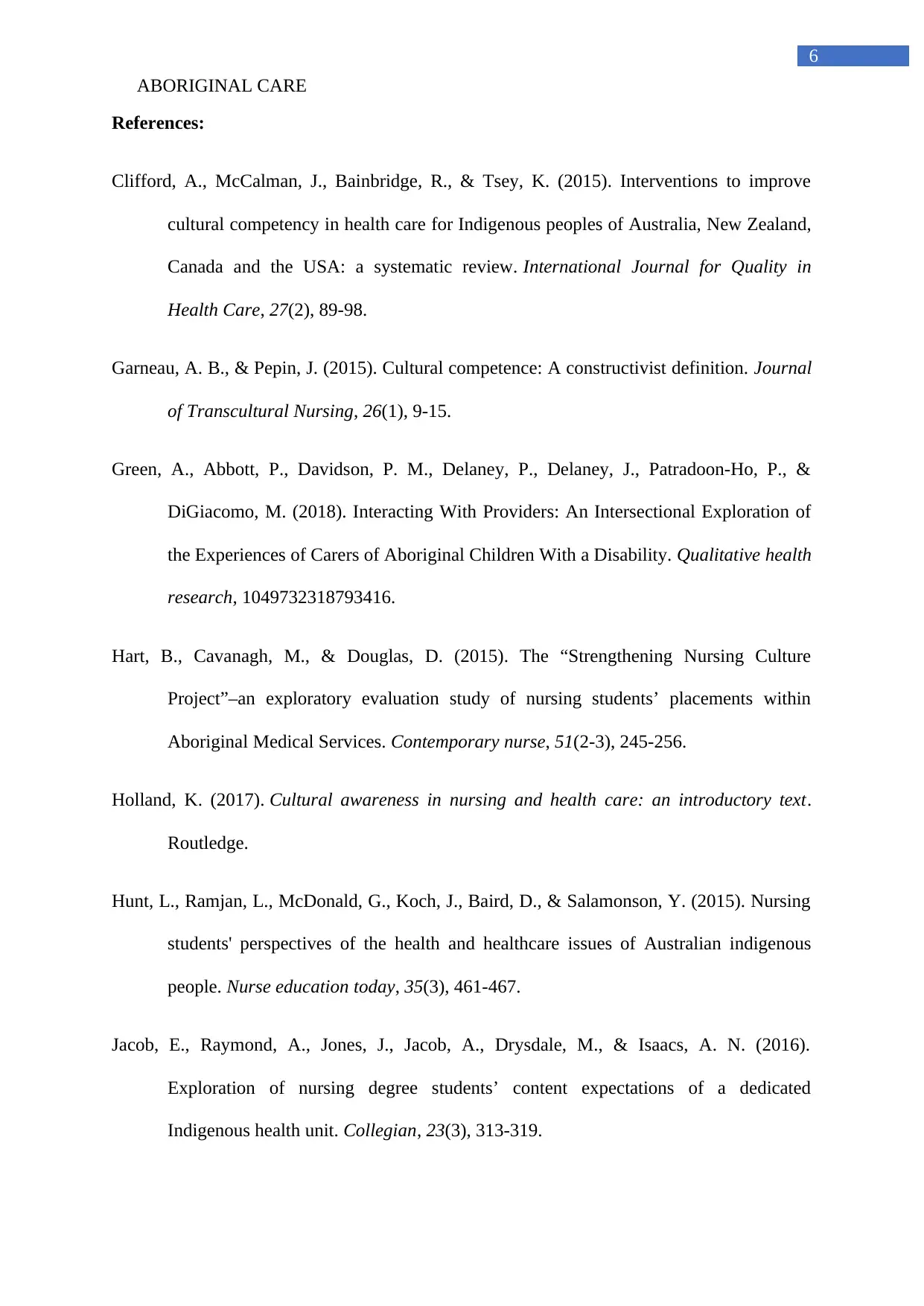
6
ABORIGINAL CARE
References:
Clifford, A., McCalman, J., Bainbridge, R., & Tsey, K. (2015). Interventions to improve
cultural competency in health care for Indigenous peoples of Australia, New Zealand,
Canada and the USA: a systematic review. International Journal for Quality in
Health Care, 27(2), 89-98.
Garneau, A. B., & Pepin, J. (2015). Cultural competence: A constructivist definition. Journal
of Transcultural Nursing, 26(1), 9-15.
Green, A., Abbott, P., Davidson, P. M., Delaney, P., Delaney, J., Patradoon-Ho, P., &
DiGiacomo, M. (2018). Interacting With Providers: An Intersectional Exploration of
the Experiences of Carers of Aboriginal Children With a Disability. Qualitative health
research, 1049732318793416.
Hart, B., Cavanagh, M., & Douglas, D. (2015). The “Strengthening Nursing Culture
Project”–an exploratory evaluation study of nursing students’ placements within
Aboriginal Medical Services. Contemporary nurse, 51(2-3), 245-256.
Holland, K. (2017). Cultural awareness in nursing and health care: an introductory text.
Routledge.
Hunt, L., Ramjan, L., McDonald, G., Koch, J., Baird, D., & Salamonson, Y. (2015). Nursing
students' perspectives of the health and healthcare issues of Australian indigenous
people. Nurse education today, 35(3), 461-467.
Jacob, E., Raymond, A., Jones, J., Jacob, A., Drysdale, M., & Isaacs, A. N. (2016).
Exploration of nursing degree students’ content expectations of a dedicated
Indigenous health unit. Collegian, 23(3), 313-319.
ABORIGINAL CARE
References:
Clifford, A., McCalman, J., Bainbridge, R., & Tsey, K. (2015). Interventions to improve
cultural competency in health care for Indigenous peoples of Australia, New Zealand,
Canada and the USA: a systematic review. International Journal for Quality in
Health Care, 27(2), 89-98.
Garneau, A. B., & Pepin, J. (2015). Cultural competence: A constructivist definition. Journal
of Transcultural Nursing, 26(1), 9-15.
Green, A., Abbott, P., Davidson, P. M., Delaney, P., Delaney, J., Patradoon-Ho, P., &
DiGiacomo, M. (2018). Interacting With Providers: An Intersectional Exploration of
the Experiences of Carers of Aboriginal Children With a Disability. Qualitative health
research, 1049732318793416.
Hart, B., Cavanagh, M., & Douglas, D. (2015). The “Strengthening Nursing Culture
Project”–an exploratory evaluation study of nursing students’ placements within
Aboriginal Medical Services. Contemporary nurse, 51(2-3), 245-256.
Holland, K. (2017). Cultural awareness in nursing and health care: an introductory text.
Routledge.
Hunt, L., Ramjan, L., McDonald, G., Koch, J., Baird, D., & Salamonson, Y. (2015). Nursing
students' perspectives of the health and healthcare issues of Australian indigenous
people. Nurse education today, 35(3), 461-467.
Jacob, E., Raymond, A., Jones, J., Jacob, A., Drysdale, M., & Isaacs, A. N. (2016).
Exploration of nursing degree students’ content expectations of a dedicated
Indigenous health unit. Collegian, 23(3), 313-319.
Paraphrase This Document
Need a fresh take? Get an instant paraphrase of this document with our AI Paraphraser
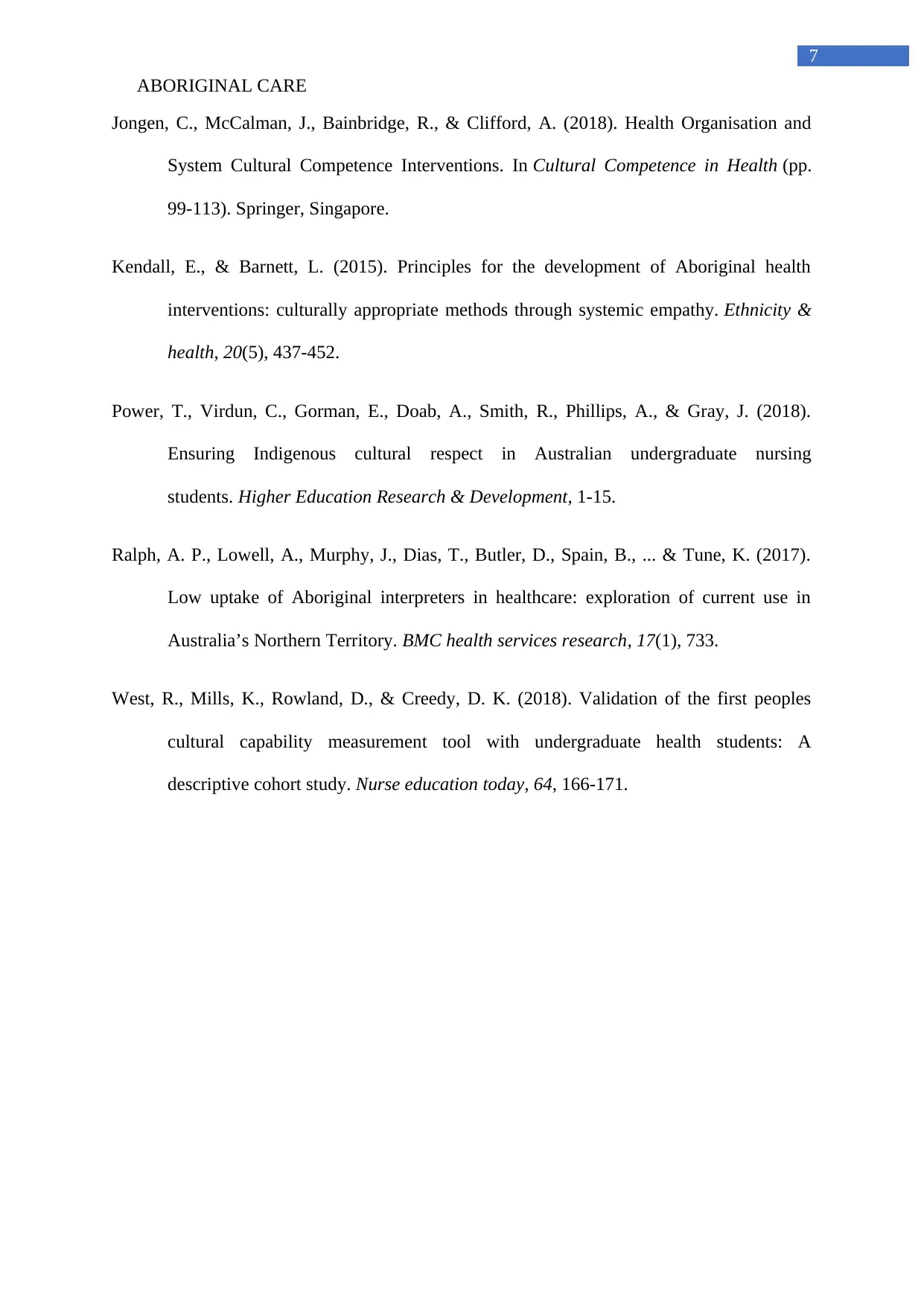
7
ABORIGINAL CARE
Jongen, C., McCalman, J., Bainbridge, R., & Clifford, A. (2018). Health Organisation and
System Cultural Competence Interventions. In Cultural Competence in Health (pp.
99-113). Springer, Singapore.
Kendall, E., & Barnett, L. (2015). Principles for the development of Aboriginal health
interventions: culturally appropriate methods through systemic empathy. Ethnicity &
health, 20(5), 437-452.
Power, T., Virdun, C., Gorman, E., Doab, A., Smith, R., Phillips, A., & Gray, J. (2018).
Ensuring Indigenous cultural respect in Australian undergraduate nursing
students. Higher Education Research & Development, 1-15.
Ralph, A. P., Lowell, A., Murphy, J., Dias, T., Butler, D., Spain, B., ... & Tune, K. (2017).
Low uptake of Aboriginal interpreters in healthcare: exploration of current use in
Australia’s Northern Territory. BMC health services research, 17(1), 733.
West, R., Mills, K., Rowland, D., & Creedy, D. K. (2018). Validation of the first peoples
cultural capability measurement tool with undergraduate health students: A
descriptive cohort study. Nurse education today, 64, 166-171.
ABORIGINAL CARE
Jongen, C., McCalman, J., Bainbridge, R., & Clifford, A. (2018). Health Organisation and
System Cultural Competence Interventions. In Cultural Competence in Health (pp.
99-113). Springer, Singapore.
Kendall, E., & Barnett, L. (2015). Principles for the development of Aboriginal health
interventions: culturally appropriate methods through systemic empathy. Ethnicity &
health, 20(5), 437-452.
Power, T., Virdun, C., Gorman, E., Doab, A., Smith, R., Phillips, A., & Gray, J. (2018).
Ensuring Indigenous cultural respect in Australian undergraduate nursing
students. Higher Education Research & Development, 1-15.
Ralph, A. P., Lowell, A., Murphy, J., Dias, T., Butler, D., Spain, B., ... & Tune, K. (2017).
Low uptake of Aboriginal interpreters in healthcare: exploration of current use in
Australia’s Northern Territory. BMC health services research, 17(1), 733.
West, R., Mills, K., Rowland, D., & Creedy, D. K. (2018). Validation of the first peoples
cultural capability measurement tool with undergraduate health students: A
descriptive cohort study. Nurse education today, 64, 166-171.
1 out of 8
Related Documents
Your All-in-One AI-Powered Toolkit for Academic Success.
+13062052269
info@desklib.com
Available 24*7 on WhatsApp / Email
![[object Object]](/_next/static/media/star-bottom.7253800d.svg)
Unlock your academic potential
Copyright © 2020–2025 A2Z Services. All Rights Reserved. Developed and managed by ZUCOL.





